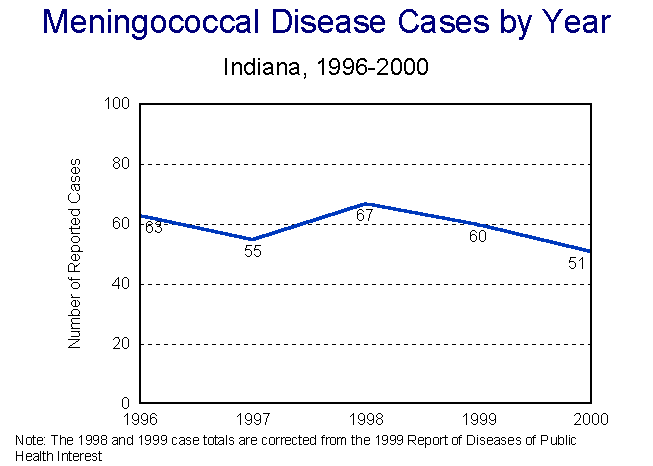Figure Men1: Meningococcal Disease Cases by Year, Indiana, 1996-2000

2000 Indiana Report of Infectious Diseases |
View ISDH's Quick Facts on Meningococcal Disease
View CDC's Meningococcal Disease page
Rates presented are per 100,000 population and are based on the U.S. 2000 Census.
| Cases | Incidence Rate |
|
| Total | 51 | 0.9 |
| Race-specific cases and rates1 | ||
| White | 39 | 0.7 |
| Black | 3 | *0.6 |
| Other2 | 1 | *0.4 |
| Sex-specific cases and rates | ||
| Female | 22 | 0.7 |
| Male | 29 | 0.9 |
Meningococcal disease most commonly manifests as meningitis or meningococcemia. It is transmitted person-to-person via respiratory droplets from the nose and throat secretions of a person infected with Neisseria meningitidis. Up to 10% of United States residents may be colonized with N. meningitidis in the nasopharynx and have no symptoms of illness.
The case fatality rate is between 5-15%. Diagnosis in a clinically compatible case is confirmed by isolating meningococci from a normally sterile site (e.g., cerebrospinal fluid (CSF), blood, synovial fluid, pleural fluid, or pericardial fluid). A probable diagnosis may be made in the absence of a positive culture if clinical purpura fulminans is present or when both clinically compatible symptoms and a positive CSF antigen test are present.
In 2000, in Indiana, there were 51 confirmed cases of meningococcal disease and two deaths reported. This represents the lowest number of cases reported from 1996-2000. The five-year median is 63 (Figure Men1). No significant racial or sexual differences were noted.
Meningococcal disease usually peaks in late winter and early spring. The incidence of meningococcal disease in 2000 peaked during the winter months (Figure Men2). Only Lake County (6 cases) and Marion County (8 cases) reported at least five cases in 2000. Cases were reported from 28 counties.
Meningococcal disease tends to strike infants, children, and young adults. Although the case rate for infants was higher than any other age group, the rate (4.7/100,000 population) was much lower than the 5-year median (17). (Figure Men3). There were two cases in students attending college.
There are 13 known serogroups (A, B, C, D, 29E, H, I, K, L, W-135, X, Y, and Z) of N. meningitidis. Serogroups A, B, C, Y, and W-135 are most frequently associated with invasive disease. As of October 2000, laboratories are required to submit N. meningitidis isolates to the ISDH Laboratories for serogrouping. Additionally, molecular subtyping can be performed by pulse-field gel electrophoresis (PFGE) on selected meningococcal isolates that may indicate a cluster of cases. Table Men1 shows serogroups identified in Indiana since 1997, when serogrouping became available.
There is a safe and effective vaccine used for persons age 2 and over that protects against infection with serogroups A, C, Y, and W-135. The current use of the vaccine includes providing it to persons with functional or anatomic asplenia, those with terminal complement component or properdin deficiencies, and travelers to countries with a high number of cases of meningococcal disease. College students, especially freshmen living in dormitories, are at increased risk for the disease and should consider vaccination.
Back to Top of Article
Back to Table of Contents
|
Figure Men1: Meningococcal Disease Cases by Year, Indiana, 1996-2000 |
|
|
Back to Reference in Text
Back to Top of Article
|
Figure Men2: Meningococcal Disease Cases by Month, Indiana, 2000 |
|
|
Back to Reference in Text
Back to Top of Article
|
Figure Men3: Meningococcal Disease - Incidence Rate by Age Group, Indiana, 1996-2000 |
|
|
Back to Reference in Text
Back to Top of Article
Back to Reference in Text
Back to Top of Article
1 - Race was unknown for 8 of the reported cases.
2 - "Other" includes American Indian/Alaska Native, Asian, Native Hawaiian/Pacific Islander, and multiracial.
* - Rate based on less than 20 cases and should be considered unstable.
Back to Table of Contents
[an error occurred while processing this directive]